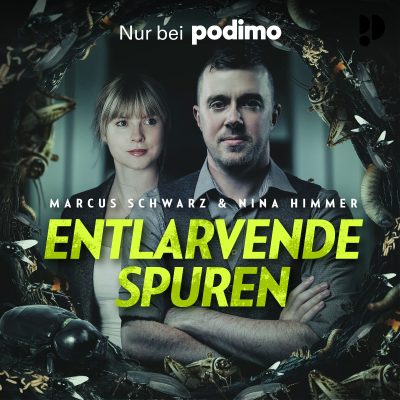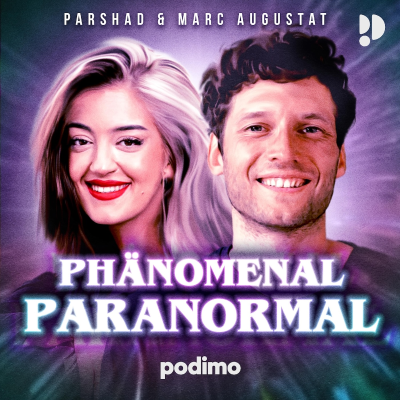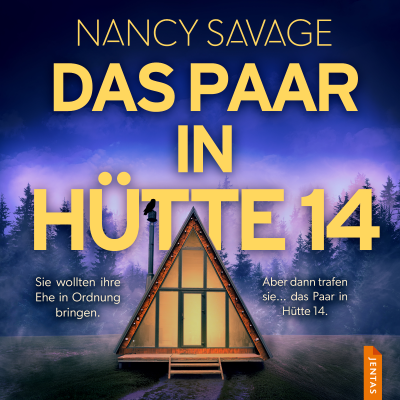
Sticky Notes: The Classical Music Podcast
Englisch
Gratis en Podimo
Kostenlos hören bei Podimo
Starte jetzt und verbinde dich mit deinen Lieblingspodcaster*innen
- Vertraut von über 1 Mio. deutschen Hörer*innen
- Über 1.000 lokale Podcasts und Shows – nur bei Podimo
- Keine Zahlung nötig
Mehr Sticky Notes: The Classical Music Podcast
Sticky Notes is a classical music podcast for everyone, whether you are just getting interested in classical music for the first time, or if you've been listening to it and loving it all your life. Interviews with great artists, in depth looks at pieces in the repertoire, and both basic and deep dives into every era of music. Classical music is absolutely for everyone, so let's start listening! Note - Seasons 1-5 will be returning over the next year. They have been taken down in order to be re-recorded in improved sound quality!
Alle Folgen
415 FolgenGustav Holst: The Planets
Mr. Holst, wherever you are, I apologize in advance for what I'm about to say. From my research, I know you resented this fact, but unfortunately, I think it's true. Here it is: despite the large catalogue of music Gustav Holst composed, much of it wonderful, he is essentially a one-hit wonder in the classical music world, à la Pachelbel, Dukas, Mascagni, and others. His one hit is a big one, though: an epic, seven-movement suite entitled The Planets. As I said, Holst was not happy about this in the slightest. He was a prolific composer and someone who devoted himself fully to his subjects. He considered other works he wrote better than The Planets, and yet, in the end, we hear very little of his other music, though since the 1980s some of it has been performed more frequently, particularly in the UK. But The Planets is truly a hit: the reason we know Holst's name today, and one of the most frequently performed pieces in the entire Western classical canon. Holst took a novel approach to his depiction of the planets. They are not ordered by their astronomical distance, but by musical cohesiveness. Nor do they depict the planets in a scientific sense; instead, they present a deeply personal astrological interpretation, something we'll explore as we discuss the piece. The orchestration is massive yet subtle, with colors unique both to the work itself and to Holst's output more broadly. It is easy to listen to and straightforward, while also somehow intensely complex and varied. It is powerful, Romantic, thrilling, joyous, mysterious, terrifying, and ultimately cosmic in both conception and execution. This is one of those pieces that people love without necessarily giving it the full respect it deserves. So today on the show, we'll learn a little about Holst's life, what led him to write The Planets, and why this piece grabs hold of us and doesn't let go throughout our journey through the stars. Join us!
Franck Symphony in D Minor
In the 1960s, Leonard Bernstein famously helped to popularize the music of a then relatively obscure composer, Gustav Mahler. His work, as well as the work of other conductors, made Mahler into a classical-music household name. Mahler's symphonies are played every year all over the world, and he is firmly ensconced in the so-called canon of standard orchestral repertoire. Would it surprise you to know that Franck's D Minor Symphony once had the same reputation? It was played almost every year by most major orchestras, it was recorded by all the great conductors, and it was a fixture of the canon just like a Brahms symphony. Nowadays you would be lucky if, outside of France and Belgium, you hear Franck's Symphony once every five years, if that. The truth is that, other than a short golden period for this symphony, it has either been controversial (around the time it was premiered) or ignored (nowadays), which is a real shame, since it is a glorious piece that I would argue is drastically underrated in our modern world. The symphony was radically innovative for its time, which probably explains some of the more virulent criticism it received, but even though those innovations now sound completely normal to our ears, they are still at the heart of what makes this symphony so profoundly satisfying to listen to. Ahead of my performances of the symphony in Lille this December, I wanted to dive in and explore this unfairly ignored masterpiece. In about 40 minutes of music in three grand movements, Franck pours his soul into this work. That phrase sounds a bit cliché, I know, but I really mean it; there is an earnestness about this music that I find deeply moving, and it is something we will explore together today. We will talk about Franck's late entry into the world of composition, his reputation as an organist, and the challenges he faced in finding acceptance as a composer. Along the way, we will discuss this gorgeous piece in all of its passion and intensity. Join us!
Ravel and Falla: Echoes of Spain
Nowadays it's hard to imagine Maurice Ravel as a "bad-boy" revolutionary, a member of a group whose name can be loosely translated as The Hooligans. To most listeners today, Ravel's music is the very picture of sumptuous beauty. But the group he belonged to, Les Apaches ("The Hooligans"), earned its name because of its members' uncompromising attitudes about music; attitudes that clashed sharply with the conservative tastes of the establishment. Another composer who belonged to Les Apaches was the Spanish composer Manuel de Falla. Falla is certainly not as well known as Ravel, but the two became fast friends when he arrived in Paris in 1907. They formed a kind of mutual-admiration society that proved immensely fruitful for both of them. Falla was deeply impressed by Ravel's Spanish-inflected music, marveling at its authenticity given that Ravel was French. But Ravel, now a symbol of French music, was the son of a Swiss father and a Spanish-speaking mother, and he was born just eleven miles from the Spanish border in the Basque region. His Spanish voice was no affectation; it came from somewhere deep within, and Falla noticed this immediately, remarking that Ravel's Rapsodie espagnole was "a Spain ideally presented by his mother." Today on the show we'll explore the Spanish world of Falla and Ravel through two central works: Falla's Nights in the Gardens of Spain and Ravel's Rapsodie espagnole. These pieces, both astonishing in their creativity and craftsmanship, offer a wonderful opportunity to compare and contrast the music and approaches of these two close friends. We'll also talk about Les Apaches and their goals, legacy, and some of their legendary members. All this and more is coming up on this final collaboration on Ravel and Friends with G. Henle Publishers! Join us!
Shostakovich Symphony No. 10 LIVE w/ The Aalborg Symphony
Longtime listeners of Sticky Notes know that Shostakovich's 10 symphony was the inaugural piece covered on the show. It's been 8 years(!) since that show, so I've totally re-written the episode and had the privilege of presenting this new version live with the Aalborg Symphony Orchestra last week in Aalborg. Shostakovich, like so many composers before him, was obsessed with musical codes and messages, with songs that expressed two or more meanings, with ideas that were at once black and white and profoundly complex. This also describes Shostakovich himself, a man who was incredibly guarded with his public persona, and even his private persona as well. It is impossible to know anything for sure with Shostakovich, and to me therein lies the greatest strength of his music. The 10th symphony has been described as a portrayal of the Stalin years, as a portrayal of obsessive love, as a requiem, as sarcastic, as humorous, as agonizing, as triumphant, as, as, as….and the truth is that like all of the greatest works of Western Classical music, it is all of those things and so much more. It is a work of profound intensity, grabbing you from the start and not letting go for nearly 50 minutes, which makes sense considering that the piece was written in the shadow of another momentous event, the death of Joseph Stalin. There are very few experiences like hearing Shostakovich's 10th symphony live, and it is the kind of piece that, by the end of it, leaves you a slightly different person than you were when it started. Today on the show, we're going to be talking about a wide range of topics, from orchestral color to Joseph Stalin, from symphonic form to obsessive love, and much more. Join us!
Barber Violin Concerto
There are so many great apocryphal stories in the long history of classical music, from the reason Tchaikovsky wrote his Sixth Symphony to what famous composers supposedly said on their deathbeds, to my favorite story: how Joseph Haydn's Symphony No. 96, The Miracle, got its name. Apparently, during the premiere of the symphony, a chandelier fell, but miraculously didn't hit anyone. Hence, The Miracle Symphony. The chandelier did, in fact, fall, but we now know it happened during the premiere of Haydn's Symphony No. 102, which has no nickname. Coincidentally, or perhaps not so coincidentally, the 96th Symphony is performed far more often than the 102nd, likely because of its nickname, even though it's the nickname of the wrong symphony. The Barber Violin Concerto has a great and true story behind it. But before certain information was revealed in 2010, the story everyone knew was quite different. The original version goes like this: Barber had completed the first two movements of his Violin Concerto and sent them to the soloist scheduled to premiere the work, Iso Briselli. Briselli didn't like the concerto, claiming it wasn't virtuosic enough, and asked Barber to write something more difficult. Barber, perhaps with an evil laugh, obliged and returned with the third movement. When Briselli received it, he realized he couldn't play it because of its extreme difficulty and ultimately withdrew from the premiere, which instead went to violinist Albert Spalding. It's a perfect "Icarus flying too close to the sun" kind of classical music story, but as it turns out, it isn't the full story. In 2010, letters were released between Barber, Briselli, and the real instigator in this little operetta, Briselli's violin teacher, Albert Meiff. I'll get into the whole story later, but it's a good one, even if it's not quite as cinematic as the legend. More important than the dispute over its last movement is the remarkable beauty and creativity of this masterful 20th-century concerto. Barber's Violin Concerto is one of my favorite pieces to play and to conduct, and it has charmed audiences ever since its premiere. It features Americana music of a kind only Copland could equal, as well as a heartbreaking oboe solo that might be one of the greatest moments in the history of American classical music. And then there's that pesky third movement, a challenge to every violinist (and orchestra) and a movement that remains controversial for many reasons.















































